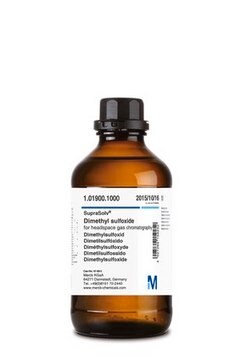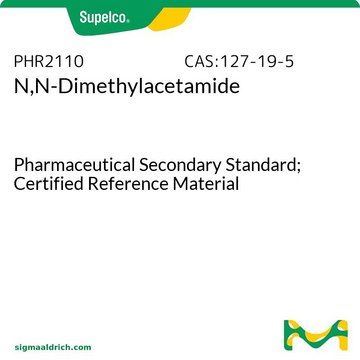270555
N,N-Dimethylacetamid
suitable for HPLC, ≥99.9%
About This Item
Empfohlene Produkte
Dampfdichte
3 (vs air)
Qualitätsniveau
Dampfdruck
2 mmHg ( 25 °C)
4 mmHg ( 38 °C)
Assay
≥99.9%
Form
liquid
Selbstzündungstemp.
914 °F
Expl.-Gr.
1.8 %, 100 °F
11.5 %, 160 °F
Methode(n)
HPLC: suitable
Verunreinigungen
<0.030% water
Abdampfrückstand
<0.001%
Brechungsindex
n20/D 1.437 (lit.)
pH-Wert
4 (20 °C, 200 g/L)
bp
164.5-166 °C (lit.)
mp (Schmelzpunkt)
−20 °C (lit.)
Dichte
0.937 g/mL at 25 °C (lit.)
λ
H2O reference
UV-Absorption
λ: 270 nm Amax: 1.00
λ: 280 nm Amax: 0.30
λ: 290 nm Amax: 0.15
λ: 310 nm Amax: 0.05
λ: 320 nm Amax: 0.03
λ: 360-400 nm Amax: 0.01
Anwendung(en)
food and beverages
SMILES String
CN(C)C(C)=O
InChI
1S/C4H9NO/c1-4(6)5(2)3/h1-3H3
InChIKey
FXHOOIRPVKKKFG-UHFFFAOYSA-N
Suchen Sie nach ähnlichen Produkten? Aufrufen Leitfaden zum Produktvergleich
Verwandte Kategorien
Anwendung
- Ternary Phase-Field Simulation of Poly(vinylidene fluoride) Microporous Membrane Structures Prepared by Nonsolvent-Induced Phase Separation with Different Additives and Solvent Treatments: This study highlights the use of N,N-Dimethylacetamide (DMAC) in the preparation of advanced poly(vinylidene fluoride) membranes, showcasing its critical role in enhancing polymer processing and membrane structures in material science (Zhang et al., 2024).
- Improved Protein Removal Performance of PES Hollow-Fiber Ultrafiltration Membrane with Sponge-like Structure: Research demonstrates DMAC′s effectiveness in the production of high-performance ultrafiltration membranes, emphasizing its importance in biomedical applications and wastewater treatment (Zhao et al., 2024).
- Poly(vinylidene fluoride) Aerogels with alpha, beta, and gamma; Crystalline Forms: Correlating Physicochemical Properties with Polymorphic Structures: This article showcases the versatility of DMAC as a solvent in the synthesis of poly(vinylidene fluoride) aerogels, linking its use to significant advancements in the understanding of polymer crystallinity and properties (Suresh et al., 2024).
- Cellulose Esters: Synthesis for Further Formation of Films with Magnetite Nanoparticles Incorporated: The study leverages DMAC for the synthesis of advanced cellulose ester films integrated with magnetite nanoparticles, illustrating its potential in developing multifunctional materials for diverse industrial applications (Furlan Sandrini et al., 2024).
Signalwort
Danger
H-Sätze
Gefahreneinstufungen
Acute Tox. 4 Dermal - Acute Tox. 4 Inhalation - Eye Irrit. 2 - Repr. 1B
Lagerklassenschlüssel
6.1C - Combustible, acute toxic Cat.3 / toxic compounds or compounds which causing chronic effects
WGK
WGK 2
Flammpunkt (°F)
147.2 °F - closed cup
Flammpunkt (°C)
64 °C - closed cup
Zulassungslistungen
Zulassungslistungen werden hauptsächlich für chemische Produkte erstellt. Für nicht-chemische Produkte können hier nur begrenzte Angaben gemacht werden. Kein Eintrag bedeutet, dass keine der Komponenten gelistet ist. Es liegt in der Verantwortung des Benutzers, die sichere und legale Verwendung des Produkts zu gewährleisten.
EU REACH SVHC Candidate List
EU REACH Annex XVII (Restriction List)
Analysenzertifikate (COA)
Suchen Sie nach Analysenzertifikate (COA), indem Sie die Lot-/Chargennummer des Produkts eingeben. Lot- und Chargennummern sind auf dem Produktetikett hinter den Wörtern ‘Lot’ oder ‘Batch’ (Lot oder Charge) zu finden.
Besitzen Sie dieses Produkt bereits?
In der Dokumentenbibliothek finden Sie die Dokumentation zu den Produkten, die Sie kürzlich erworben haben.
Kunden haben sich ebenfalls angesehen
Unser Team von Wissenschaftlern verfügt über Erfahrung in allen Forschungsbereichen einschließlich Life Science, Materialwissenschaften, chemischer Synthese, Chromatographie, Analytik und vielen mehr..
Setzen Sie sich mit dem technischen Dienst in Verbindung.







